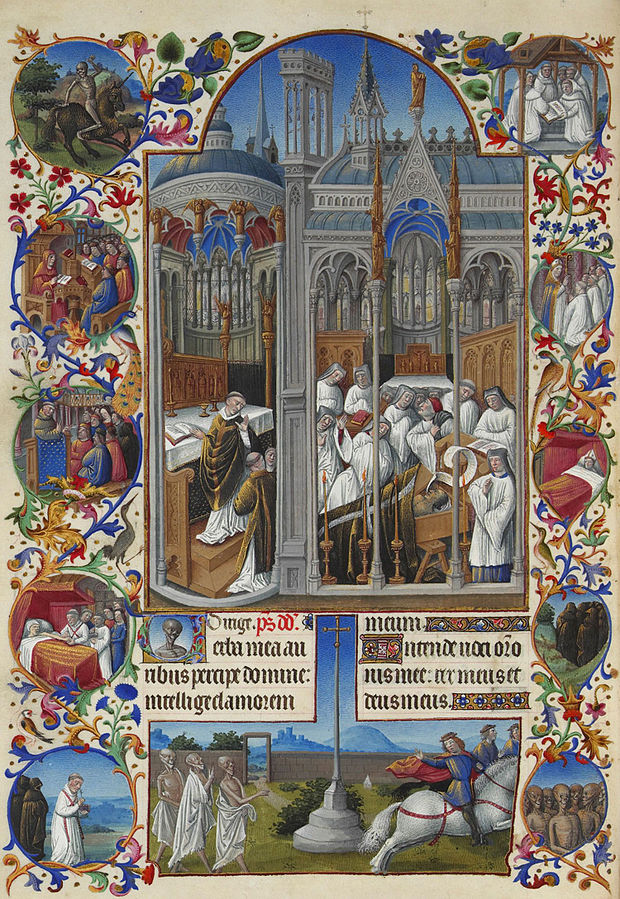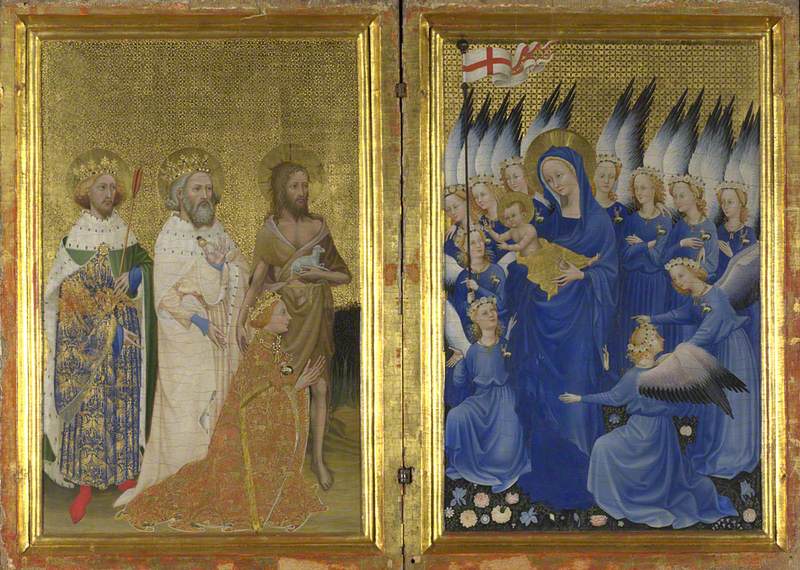After a week of much colder weather, the flower garden is definitely in winter mode, save for a few brave camellias now venturing to bloom again. They are one of the most beautiful aspects of Southern gardens for me, and I can never plant enough of them, particularly the whites and pale shell pinks.
Since there is so little variety outside, I have been going through flower paintings in my mind's eye. This was made all the easier as I have been thinking about medieval times, when religious texts were becoming more and more luxurious, with an increasing demand for Books of Hours by wealthy patrons. Many of these jewel-like small creations are bedecked with the most wonderful depictions of flowers, many of them with floral symbols to underline the religious truths of the texts. An introduction to some of these images, with colours glowing and flowers ranging from pinks to violets, asters, forget-me-nots, daisies or roses, shows that by 1410, artists were producing the most amazing Books of Hours for patrons such as Catherine of Cleves, Flemish or French nobility.
Produced in the Netherlands in about 1460, this Book of Hours is from the Euing Collection. University of Glasgow
Perhaps the most famous is Les Très Riches Heures du Duc de Berry, painted from 1412-1416 almost exclusively by the three Limbourg brothers, Paul, Henri and Jean. Interestingly, there are not many details of flowers, but even here, in one image of a Funeral Service, campanula wander amongst the text on one column.
Très Riches Heures du duc de Berry. Folio 86, verso: The Funeral of Raymond Diocrès, between 1411 and 1416 and between 1485 and 1486
By 1500, the use of flowers in Books of Hours was widespread, as can be seen in this edition done in Rouen, France, held in the Bodleian Library, Oxford.
Palma's Book of Hours, silverpoint and watercolour, Jeannine Cook artist
I created Palma's Book of Hours, done in silverpoint and watercolour, thinking of the tobacco/nicotiana as the flowers opened and closed each day in a rhythm which marked off the hours for me in perfumed regularity.
Another early devotional book, the Wilton Diptych, was created in England c. 1395-1399, for the purposes of accompanying its rich travelling owner. In one scene, pink roses adorn the angels' heads, but apparently they were originally the red Rosa Gallica, one of the earliest known rose varieties.
Richard II presented to the Virgin and Child by his Patron Saint John the Baptist and Saints Edward and Edmund (‘The Wilton Diptych’), Anonymous, ca. 1395, egg on oak, 53 x 37 cm, National Gallery
Detail of the Wilton Diptych
Detail of the Wilton Diptych
An image of this can be found, amongst others, on a wonderful web page on the BBC. This site depicts a wide variety of flower paintings down the ages and it underlines the continuous attraction for artists of flowers, in their beautiful diversity and elegance. This is hardly surprising when one thinks that we humans have always known flowers - they have been in existence for about 120 million years. Fascinatingly, they have apparently always played a central role for humans - archaeologists have found a burial site for a man, two women, and a child, in a cave in Iraq. They were Neanderthals, living in these Pleistocene caves. On this burial site had been placed a bunch of flowers.
The Greeks placed great store on flowers, such as violets and had them in their houses and wore them in crowns at feast times. The Romans did the same and held festivals of flowers to honour the goddess, Flora. Remember the fresco uncovered in Pompeii of Flora and her flowers. Roses were the flower of the goddess of love, Venus; roses too have always been celebrated by Confucians and Buddhists.
The early Renaissance artists loved to depict lilies in Annunciation scenes - Fra Filippo Lippi was one of the early ones in 1450, for instance. Leonardo da Vinci did the most exquisite drawings of Regale lilies. You can almost feel the weight of the flowers as he studied them and drew them in pen and ink. The Pre-Raphaelites also loved lilies - on the BBC site I mentioned earlier, there is a reproduction of Dante Gabriel Rossetti's "Annunciation" with the lilies the most graceful complement. Then there is the wondrously atmospheric John Singer Sargent painting, "Carnation, Lily, Lily, Rose", done in 1885-6, with the children and beautiful tall, proud lilies in the luminous twilight.
The seventeenth century was also the heyday of Dutch flower painting, done by both men and women. One of the most successful was Rachel Ruysch, while another was Judith Leyster, who did some silverpoint drawings of tulips. Flemish-born Ambrosius Bosschaert was one of the first to specialise in flower paintings and others like Jan van Huysum and Jan Bruegel followed his footsteps with looser, often more brilliant styles. Since a lot of the Dutch flower paintings were also about Holland's wide-flung world power and dominance, as well as the flowers' beauty, the artists did not hesitate to mix up flowers from all parts of the world, which would never bloom at the same time. They composed the most astonishing mixes in their arrangements, requiring a lot of time and ingenuity to pull the complex compositions together.
France forged a different approach to flower painting. Pierre Joseph Redouté began his highly talented life as a flower painter under Queen Marie Antoinette's patronage, but the Empress Josephine hastened to continue the patronage after the Revolution. His wonderfully sensitive "portraits" of flowers and plants are so realistic one can almost smell the perfume, for instance, of his roses, and he managed also to combine careful science with astonishing art. He helped pioneer a whole sub-group of botanical artists whose numbers, today, have swelled amazingly and fruitfully throughout the world. Take a look at the American Society of Botanical Artists' website, for instance - I am proud to be a member of the burgeoning Society. (Dr. Shirley Sherwood, of London, has been one of the major supporters of this renaissance of botanical art, and now her collection is not only showing in many venues around the world, but also at Kew in a permanent, dedicated gallery.)
The second half of the 19th century produced some wonderful flower painters in France - Manet did some exquisite studies of flowers in vases, while Henri Fatin-Latour became famous for the way in which he painted roses and peonies, larkspur and other wonderful summer flowers. He would wait until the roses almost dropped their petals, so as to be able to capture that ultimate fullness of musky beauty in each petal. Monet delighted in his flower garden, culminating with the glories of Giverny and his lily pond, while Renoir and Degas were no slouches in their depictions of chrysanthemums, geraniums and other plants. Of course, everyone knows about Vincent van Gogh and his passionate sunflower paintings – he had moved far from the exquisite jewels of medieval flower painting, but left all of us the richer for both approaches. Odilon Redon comes to mind too for his pastel studies of flowers that were far beyond just the botanical and yet are brilliantly evocative in their somewhat strange feel.
The twentieth century seems to have always had its lovers of flower paintings. An interesting note I saw was that 55% of all art considered "decorative" and available today is floral art. No wonder there was a reaction against flower paintings in juried shows for a long time! Nonetheless, a lot of us artists have continued to celebrate flowers in art - they are just too important to ignore, and besides, when a garden is in the depths of winter, at least one can evoke warmer times by having paintings or drawings of flowers on the walls.





